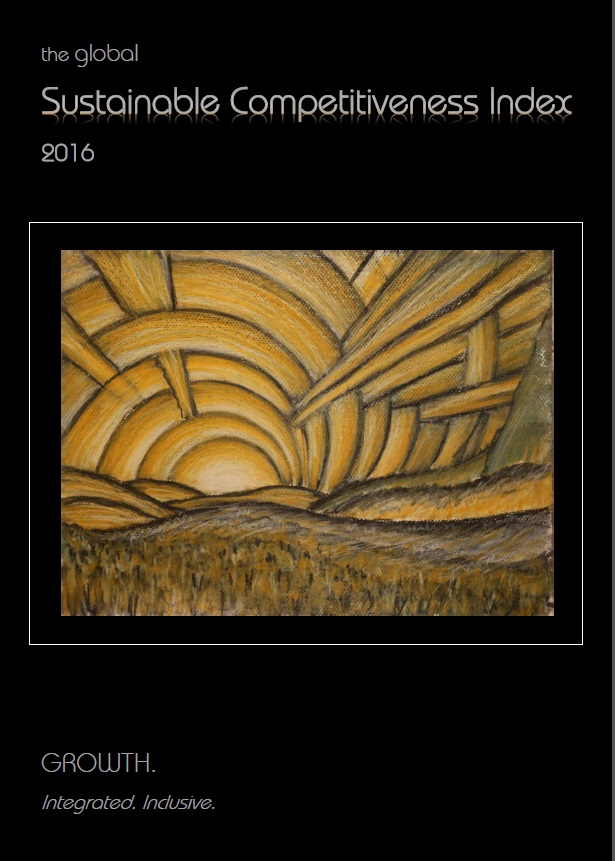The Global Sustainable Competitiveness Index 2016
1 The Global Sustainable Competitiveness Index
The Global Sustainable Competitiveness Index (GSCI) is an index based on 109 quantitative performance indicators grouped into the 5 pillars of sustainable competitiveness. Data sets have been scored both for the current levels as well as the recent development of the indicator in order to not only reflect current standing, but also development potential. The GSCI aims to evaluate the ability of countries to create and sustain wealth that does not negatively affect the underlying fundament of wealth creation, based on the definition of Sustainable Development. The GSCI integrates all aspects that make economies lasting successful and is not limited commonly used financial factors (such as the GDP, or credit ratings), or other output measurements such as expressed in the WEF’s Competitiveness Index.
The 2016 Index is, again, a Scandinavian party: all 5 top spots are occupied by the Scandinavian economies, lead for the first time by Sweden.
1.1 What?
The Sustainable Competitiveness Model
The Sustainable Competitiveness model has been developed with an integrated view of what characterises the current and the future state (i.e. competitiveness) of a nation-economy. It is based on a competitiveness model that incorporates all relevant pillars of sustained growth and wealth creation of a nation – natural capital availability, resource efficiency, social cohesion, government-led development direction, and innovation and business capabilities. The Sustainable Competitiveness Index also integrates data trends over time to allow for a better expression of future development potential.
The Pillars of Sustainable Competitiveness
The main pillars of the Sustainable Competitiveness Model are:
• Natural Capital: the given natural environment within the frontiers of a country, including availability of resources, and the level of the depletion of those resources.
• Social Capital: health, equality, security, freedom and life satisfaction within a country
• Resource Management: the efficiency of using available resources (human, technology, natural and financial resources), both domestic and imported) as a measurement of operational competitiveness in a resource-constraint World.
• Sustainable Innovation: the capability of a country to generate wealth and jobs through innovation and value-added industries in the globalised markets
• Governance Capability: the ability of governing bodies and authorities to provide a framework for sustained and sustainable wealth generation
Sustainable competitiveness means that current wealth levels are not in danger of being reduced or diminished through over-exploitation of resources (i.e. natural and human resources), the lack of innovative edge required to compete in the globalised markets (i.e. education), or the discrimination, marginalisation or exploitation of segments of a society.
The Global Sustainable Competitiveness Index: Measuring development, wealth, and prosperity – inclusively.
1.2 Why?
Conventional country comparisons, rankings and ratings are based on economic and/or financial indicators. However, economic and financial indicators - at best - reflect current economic success; without looking at or explaining what makes this economic success possible. They also fail to account for current developments – financial and non-financial - that shape future potential or decline.
In addition, economic activities have adverse side-effects on the environment and societies: pollution and depletion of natural resources, climate change, health impacts, inequality and impacts on the socio-cultural fabric of a country. Neglect of these factors can diminish the very basis of current economic output and success measured in conventional ratings.
Economic and financial indicators are therefore insufficient measurements for risk and investment analysis – or credit ratings. In other words: “competitiveness” in its current meaning and commonly used financial/industrial indicators are an insufficient basis for investment decisions and policy making.
The Sustainable Competitiveness Index is based on a model that integrates economic and financial indicators with the pillars that make the business success possible in the first place. It is based purely on comparable and measurable performance data collected by recognised international agencies, therefore excluding all subjectivity.
The Sustainable Competitiveness Index was developed to measure the level of development – and the potential for development – of a country-economy inclusively.
To download the full report, please click here.

